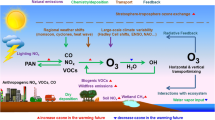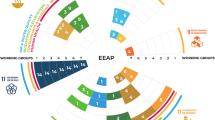Abstract
Data from the AIRS satellite infrared spectrometer and NCEP reanalysis are used to study the formation of the ozone miniholes (OMHs) and their influence on the levels of UV radiation (UVR) from May 22 to 24, 2021, in the middle and southern parts of the Volga region and the south of Urals and Western Siberia, and from March 16 to 18, 2022, in the northwest of the European Russia. These OMHs form due to the anticyclone-caused tropopause rise and the transport of ozone-depleted air masses from the subtropics. In the former period, in the OMH region with negative total ozone (TO) anomalies up to ~20% of the average values over 2003 to 2021, the positive UVR anomalies attained 40–60%, and the UV index increased from ~6 to ~8. In the latter period, in the OMH region with negative TO anomalies up to ~ −40%, the positive UVR anomalies attained 40–60%, and the UV index increased from ~1 to ~2. The UVR flux calculations with an original radiation model confirmed the UVR increase in the OMH region revealed using satellite observations.











Similar content being viewed by others
REFERENCES
V. E. Fioletov, “Ozone climatology, trends, and substances that control ozone,” Atmosphere—Ocean, No. 46:1, 39–67 (2008).
WMO. Executive Summary of Scientific Assessment of Ozone Depletion (WMO, Genewa 2022.).
P. W. Barnes, T. M. Robson, P. J. Neale, C. E. Williamson, R. G. Zepp, S. Madronich, S. R. Wilson, A. L. Andrady, A. M. Heikkila, G. H. Bernhard, A. F. Bais, R. E. Neale, J. F. Bornman, M. A. Jansen, A. R. Klekociuk, J. Martinez-Abaigar, S. A. Robinson, Q.-W. Wang, A. T. Banaszak, D.-P. Hader, S. Hylander, K. C. Rose, S.-A. Wangberg, B. Foereid, W.-C. Hou, R. Ossola, N. D. Paul, J. E. Ukpebor, M. P. Andersen, J. Longstreth, T. Schikowski, K. R. Solomon, B. Sulzberger, L. S. Bruckman, K. K. Pandey, C. C. White, L. Zhu, M. Zhu, P. J. Aucamp, J. B. Liley, R. L. McKenzie, M. Berwick, S. N. Byrne, L. M. Hollestein, R. M. Lucas, C. M. Olsen, L. E. Rhodes, S. Yazar, and A. R. Young, “Environmental effects of stratospheric ozone depletion, uv radiation, and interactions with climate change: UNEP environmental effects assessment panel, update 2021,” Photochem. Photobiol. Sci. 21, 275–301 (2022).
G. Manney, M. Santee, M. Rex, N. Livesey, M. Pitts, P. Veefkind, E. Nash, I. Wohltmann, R. Lehmann, L. Froidevaux, L. Poole, M. Schoeberl, D. Haffner, J. Davies, V. Dorokhov, H. Gernandt, B. Johnson, R. Kivi, E. Kyro, N. Larsen, P. Levelt, A. Makshtas, C. McElroy, H. Nakajima, M. Parrondo, D. Tarasick, P. Gathen, K. Walker, and N. Zinoviev, “Unprecedented Arctic ozone loss in 2011,” Nature 478, 469–475 (2011).
N. D. Tsvetkova, P. N. Vargin, A. N. Lukyanov, B. M. Kiryushov, V. A. Yushkov, and V. U. Khattatov, “Studying chemical ozone depletion and dynamic processes in the Arctic stratosphere in the winter 2019/2020,” Russ. Meteorol. Hydrol. 46 (9), 606–615 (2021).
S. P. Smyshlyaev, P. N. Vargin, and M. A. Motsakov, “Numerical modeling of ozone loss in the exceptional Arctic stratosphere winter-spring of 2020,” Atmosphere 12, 1470 (2021).
I. Wohltmann, P. Gathen, R. Lehmann, M. Maturilli, H. Deckelmann, G. L. Manney, J. Davies, D. Tarasick, N. Jepsen, R. Kivi, N. Lyall, and M. Rex, “Near-complete local reduction of Arctic stratospheric ozone by severe chemical loss in spring 2020,” Geophys. Rev. Lett. 47, e2020GL089547 (2020).
G. H. Bernhard and V. E. Fioletov, J.-U. Gross, I. Ialongo, B. Johnsen, and K. Lakkala, “ Record-breaking increases in Arctic solar ultraviolet radiation caused by exceptionally large ozone depletion in 2020,” Geophys. Rev. Lett. 47 (2020). https://doi.org/10.1029/2020GL089547
A. Karpechko, L. Backman, L. Tholix, I. Ialongo, M. Andersson, V. Fioletov, A. Heikkila, B. Johnsen, T. Koskela, E. Kyrola, K. Lakkala, C. Myhre, M. Rex, V. Sofieva, J. Tamminen, and I. Wohltmann, “The link between springtime total ozone and summer UV radiation in Northern Hemisphere extratropics,” J. Geophys. Res. 118, 8649–8661 (2013).
L. Pinault and V. Fioletov, “Sun exposure, sun protection and sunburn among Canadian adults,” Statistics Canada, Catalogue No. 82-003-X. Health Reports 28 (5), 12–19 (2017).
J. E. Gershenwald and G. P. Guy, “Stemming the rising incidence of melanoma: Calling prevention to action,” J. Nat. Cancer Institute 108 (1) (2015). https://doi.org/10.1093/jnci/djv381
Malignant Neoplasms in Russia in 2020 (Morbidity and Mortality), Ed. by A.D. Kaprin and V.V. Starinskii (P.A. Gertsen Moscow Scientific Research Oncology Institute, Moscow, 2021) [in Russian].
A. E. Czerwinska and J. W. Krzyscin, “Climatological aspects of the increase of the skin cancer (melanoma) incidence rate in Europe,” Int. J. Climatol. 40 (6), 3196–3207 (2019).
T. Egorova, E. Rozanov, J. Grobner, M. Hauser, and W. Schmutz, “Montreal protocol benefits simulated with CCM SOCOL,” Atmos. Chem. Phys. 3, 3811–3823 (2013).
W. Ball, J. Alsing, D. Mortlock, J. Staehelin, J. Haigh, T. Peter, F. Tummon, R. Stubi, A. Stenke, J. Anderson, A. Bourassa, S. Davis, D. Degenstein, S. Frith, L. Froidevaux, C. Roth, V. Sofieva, R. Wang, J. Wild, P. Yu, J. Ziemke, and E. Rozanov, “Evidence for a continuous decline in lower stratospheric ozone offsetting ozone layer recovery,” Atmos. Chem. Phys. 18, 1379–1394 (2018).
J.-P. Pommereau, F. Goutail, A. Pazmino, F. Lefevre, M. P. Chipperfield, W. Feng, M. V. Roozendael, N. Jepsen, G. Hansen, R. Kivi, K. Bognar, K. Strong, K. Walker, A. Kuzmichev, S. Khattatov, and V. Sitnikova, “Recent Arctic ozone depletion: Is there an impact of climate change?,” C. R. Geosci. 350, 347–353 (2018).
V. Zubov, E. Rozanov, T. Egorova, I. Karol, and W. Schmutz, “Role of external factors in the evolution of the ozone layer and stratospheric circulation in 21st century,” Atmos. Chem. Phys. 13, 4697–4706 (2013).
N. E. Chubarova, E. Yu. Zhdanova, V. U. Khattatov, and P. N. Vargin, “Actual problems in the study of UV radiation and the ozone layer,” Vestn. RAN 86 (9), 839–846 (2016).
P. Gathen, R. Kivi, I. Wohltmann, R. Salawitch, and M. Rex, “Climate change favours large seasonal loss of Arctic ozone,” Nature Commun. 12, 1–17 (2021).
P. N. Vargin, S. V. Kostrykin, E. M. Volodin, A. I. Pogoreltsev, and K. Wei, “Arctic stratosphere circulation changes in the 21st century in simulations of INM CM5,” Atmosphere 13 (25) (2022).
P. M. James, “A climatology of ozone mini-holes over the Northern Hemisphere,” Int. J. Climatol. 18, 1287–1303 (1998).
D. Peters, J. Egger, and G. Entzian, “Dynamical aspects of ozone mini-hole formation,” Meteorol. Atmos. Phys. 55, 205–214 (1995).
Y. Timofeyev, S. Smyshlyaev, Y. Virolainen, A. S. Garkusha, A. V. Polyakov, M. A. Motsakov, and O. Kirner, “Case study of ozone anomalies over northern Russia in the 2015/2016 winter: Measurements and numerical modeling,” Ann. Geophys. 36, 1495–1505 (2018).
S. A. Sitnov and I. I. Mokhov, “Relationship of the ozone mini-hole over Siberia in January 2016 to atmospheric blocking,” Dokl. Earth Sci. 500 (1), 772–776 (2021).
N. E. Chubarova, Yu. M. Timofeev, Ya. A. Virolainen, and A. V. Polyakov, “Estimates of UV indices during the periods of reduced ozone content over Siberia in winter-spring 2016,” Atmos. Ocean. Opt. 32 (2), 177–179 (2019).
S. A. Sitnov and I. I. Mokhov, “Satellite-derived peculiarities of total ozone field under atmospheric blocking conditions over the European part of Russia in summer 2010,” Russ. Meteorol. Hydrol. 41 (1), 28–36 (2016).
I. I. Mokhov and A. V. Timazhev, “Atmospheric blocking and changes in its frequency in the 21st century simulated with the ensemble of climate models,” Russ. Meteorol. Hydrol. 44 (6), 369–377 (2019).
D. Barriopedro, M. Anto, and J. A. Garcia, “Atmospheric blocking signatures in total ozone and ozone miniholes,” J. Clim. 23, 3967–3983 (2010).
N. S. Ivanova, I. N. Kuznetsova, and E. A. Lezina, “Ozone content over the Russian Federation in the second quarter of 2021,” Russ. Meteorol. Hydrol. 46 (8), 553–559 (2021).
N. S. Ivanova, I. N. Kuznetsova, and E. A. Lezina, “Ozone content over the Russian Federation in the first quarter of 2022,” Meteorol. Gidrol., No. 6, 137–143 (2022).
J. G. Acker and G. Leptoukh, “Online analysis enhances use of NASA Earth science data,” EOS. Trans. Am. Geophys. Union 8 (2), 14–17 (2007).
H. H. Aumann, M. T. Chahine, C. Gautier, M. D. Goldberg, E. Kalnay, L. M. McMillin, H. Revercomb, P. W. Rosenkranz, and W. L. Smith, “AIRS/AMSU/HSB on the Aqua Mission: Design, science objectives, data products, and processing systems,” IEEE Trans. Geosci. Remote Sens. 41, 253–264 (2003).
E. Kalnay, M. Kanamitsu, R. Kistler, W. Collins, D. Deaven, L. Gandin, M. Iredell, S. Saha, G. White, J. Woollen, Y. Zhu, M. Chelliah, W. Ebisuzaki, and W. Higgins, “The NCEP/NCAR 40-year reanalysis project,” Bull. Am. Meteorol. Soc. 77, 437–470 (1996).
N. Chubarova and E. Zhdanova, “Ultraviolet resources over Northern Eurasia,” J. Photochem. Photobiol., Ser. B: Biol. 127, 8–51 (2022).
H. Zhang, J. Wang, GarciaL. Castro, J. Zeng, C. Dennhardt, Y. Liu, and N. A. Krotkov, “Surface erythemal UV irradiance in the continental United States derived from ground-based and OMI observations: Quality assessment, trend analysis and sampling issues,” Atmos. Chem. Phys. 19, 2165–2181 (2019).
K. Vanicek, T. Frei, Z. Litynska, and A. Schmalwieser, UV Index for the Public (European Communities, Brussels, 2000).
T. B. Fitzpatrik, “The validity and practicality of sunreactive skin types I through VI,” Arch. Dermatol. 124, 869–871 (1988).
www.who.int/ru/news-room/questions-and-answers/item/ultraviolet-(uv)-index. Cited November 5, 2022.
B. A. Fomin and G. E. Kolokutin, “Effective parameterizations of biologically active UV radiation absorption by atmospheric ozone,” Atmos. Ocean. Opt. 30 (6), 495–501 (2017).
P. N. Vargin, A. N. Lukyanov, A. S. Vyazankin, and V. V. Guryanov, “Dynamic processes of the Arctic stratosphere in the 2020–2021 winter,” Izv., Atmos. Ocean. Phys. 57 (6), 568–580 (2021).
P. N. Vargin, A. V. Koval, and V. V. Guryanov, “Arctic stratosphere dynamical processes in the winter 2021–2022,” Atmosphere 13, 1550 (2022).
Funding
Analysis of meteorological conditions was supported by the Russian Science Foundation (project no. 19-17-0024); study of ozone minihole formation was supported by the Russian Foundation for Basic Research (project no. 20-55-14 003).
Author information
Authors and Affiliations
Corresponding authors
Ethics declarations
The authors declare that they have no conflicts of interest.
Additional information
Translated by O. Bazhenov
About this article
Cite this article
Vargin, P.N., Fomin, B.A. & Semenov, V.A. Influence of Ozone Miniholes over Russian Territories in May 2021 and March 2022 on UV Radiation Revealed in Satellite Observations and Simulation. Atmos Ocean Opt 36, 578–589 (2023). https://doi.org/10.1134/S1024856023050172
Received:
Revised:
Accepted:
Published:
Issue Date:
DOI: https://doi.org/10.1134/S1024856023050172




